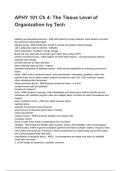APHY 101 Ch 4: The Tissue Level of
Organization Ivy Tech
adhering junctions/desmosomes - ANS-cells linked by protein plaques; resist tension; prevents
the cells from being pulled apart
adipose tissue - ANS-White fat is similar to areolar but greater nutrient storage
cell is adipocyte (stores nutrients - fat/lipids)
shock absorption, insulation, energy storage
Brown fat uses lipid fuels to provide warm rather than energy (ATP)
areolar connective tissue - ANS-support and bind other tissues - universal packing material
between other tissues
provide reservoir of water and salts
when inflamed soaks up fluid -> edema
basement membrane of epithelial tissues - ANS-anchors epithelium to underlying connective
tissue
blood - ANS-a fluid connective tissue; cells (erythrocytes, leukocytes, platelets); matrix has
plasma (fluid) and no fibers (unless clotted); functions to carry (O2, CO2, nutrients, wastes,
other substances like hormones)
blood connective tissue - ANS-atypical connective tissue - is a fluid
contains blood cells and platelets
functions in transport
bone - ANS-compact or spongy; cells (osteoblasts and osteocytes); matrix is gel-like ground
substance with calcified inorganic salts and collagen fibers; functions to resist compression and
support
bone connective tissue - ANS-also called osseous tissue
calcified matrix
supports and protects body structures
stores fat and synthesizes blood cells in cavities
richly vascularized
cardiac muscle - ANS-branching, striated, uninucleate cells
involutary control
found in walls of the heart to propel blood into circulation
cartilage - ANS-tought yet flexible; types (hyaline, elastic, fibrocartilage); cells (chondroblasts,
chondrocytes); matrix is ground substance (gel-like) and fibers (collagen, elastic, reticular); lacks
nerve fibers and avascular; functions to resist compression by holding water (up to 80% water)
and cushion/support body structures
classification of epithelial tissue - ANS-1. by arrangement as simple (one layer) or stratified
(more than one layer)
2. by cell shape as squamous, cuboidal, columnar
, -stratified epithelia are named according to the shape of the cells in the apical layer
collagenous fibers - collagen - ANS-thick threads of protein, grouped in long, parallel bundles
that are flexible but only slightly elastic; these fibers have great tensile strength (resist being
pulled apart); found in matrix these fibers also form ligaments (which connects bones to bones)
and tendons (which connect muscles to bones)
columnar - ANS-Elongated cells with oval nuclei
connective tissue - ANS-function= bind, support, protect, fill spaces, store fat, and produce
blood cells. location= widely distributed throughout the body. characteristics= good blood supply,
cells are farther apart, have extracellular matrix in between
connective tissue classes - ANS-connective tissue proper
cartilage
bone
blood
connective tissue proper - ANS-loose (areolar, adipose, reticular) and dense (regular, irregular,
elastic); cells (fibroblasts, fibrocytes, immune cells, adipocytes); matrix is ground substance
(gel-like) and fibers (collagen, elastic, reticular); functions - binding, resist mechanical stress,
reservoir for water and salts, and nutrient (fat) storage
cuboidal - ANS-cube-shaped cells with round nuclei
cutaneous membrane - ANS-membrane exposed to air and is dry; skin
dense irregular connective tissue - ANS-bundles of collagen thicker and irregularly arranged
resists tension from many directions
fibroblasts manufacture fibers and ground substance
found in dermis, fibrous joint capsules, fibrous coverings of some organs
dense regular connective tissue - ANS-closely packed bundles of collagen fibers running
parallel to direction of pull; with great resistance to pulling and little stretch
fibroblasts manufacture fibers and ground substance
poorly vascularized
elastic cartilage - ANS-functions to support and reinforce but with more elastic fibers in matrix;
maintains shape of a structure while allowing flexibility; found in external ear and epiglottis
elastic connective tissue - ANS-high proportion of elastic fibers
some ligaments are very elastic (like those connecting adjacent vertebrae)
also found in walls of larger arteries
elastic fibers - ANS-composed of elastin, very stretchy, snap back to normal length and shape,
not as strong as collagen; vocal cords, air passages, skin
endocrine glands - ANS-Ductless glands; secrete hormones that travel through blood and lymph
to target cells
epithelial tissue - ANS-function= protection, excretion, absorption, secretion. Location= cover
body surface, cover and line internal organs, compose glands. characteristics= lack blood
vessels (avascular), cells readily divide, cells are tightly packed, polarity, innervated
exocrine glands - ANS-Secrete products into ducts; secretions released onto body surfaces
(skin) or into body cavities; examples include mucous, sweat, oil, and salivary glands
fibroblast - ANS-cells in the connective tissue that produce extracellular fibers ( collagenous,
elastic and reticular fibers)




